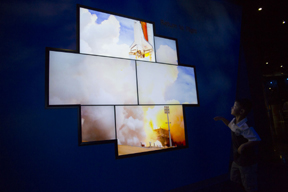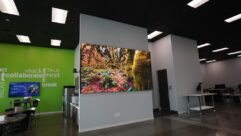
SVC Podcast – Show Notes – Show 148-1
In this edition of the SVC Podcast, SVC Contributing Editor Bennett Liles talks with Brian Karr of Rockledge Design Group (RDG) about the newly opened Forever Remembered Memorial at Kennedy Space Center for the crews of Space Shuttles Challenger and Columbia. Brian gained valuable experience through his work with NASA’s Advanced Imaging Lab and he amassed a huge collection of high resolution images and video of the Space Shuttle program. This was applied to the video wall exhibit at the memorial.
Links of interest:
- Rockledge Design Group (RDG)
- Kennedy Space Center
- NASA’s press release on the opening of the Forever Remembered Memorial
Download Podcast Here:
https://s3.amazonaws.com/nb-svc/public/public/149-1_Forever_Remembered__…
From Sound & Video Contractor Magazine, this is the SVC Podcast with Brian Karr of Rockledge Design Group, RDG. Show notes for the podcast are on the web site of Sound & Video Contractor Magazine at svconline.com.
In the quest for space exploration there have been many triumphs and some tragedies along the way. NASA wanted the visitors to Kennedy Space Center to come away having known more about those who gave their lives in taking us into space. They gave Rockledge Design Group, RDG, the job of designing a fitting memorial, and Brian Karr is going to tell us how he handled the task. That’s all next on the SVC Podcast.
Brian, good to have you with us on the SVC Podcast from Rockledge Design Group, better known as RDG. One of the most interesting projects you’ve had there lately was NASA’s Forever Remembered Memorial at Kennedy Space Center. There is a lot of emotion involved when remembering those who have given their lives in the space exploration effort. Tell us about the Forever Remembered Memorial; where it is at KSC and how you get there.
Well, the Forever Remembered Gallery or Memorial is at the Kennedy Space Center Visitor Complex. So that’s the area you would come to to see Shuttle Atlantis or to tour the other exhibits. And the visitor’s center is located actually just outside the gates of the main entrance to Kennedy Space Center. And what they did is there’s an area almost directly to the side, but almost underneath Shuttle Atlantis in the Atlantis building that they set aside as a place for this memorial. And what it commemorates is the crews of Shuttle Challenger and Shuttle Columbia that were lost. And there’s never really been a permanent exhibit before so this is the first permanent exhibit that was built to basically introduce people to the crews, introduce them to what they were like, and to really see them as people. [Timestamp: 2:08]
Right and when these accidents have happened the press jumps right on it and they pretty much all say the same thing at the time and talk about the crew and that subsides pretty quickly. But if you really want to get to know the flight crews and their individual stories, this is the place to do it.
Absolutely. Absolutely. And one of the things that was fascinating for me is a lot of people are familiar with some of the astronauts, and certainly the teacher in space, but going through this process and see some of the items that the families offered to go into the individual cases for each astronaut, you realize just how incredible these people were. I mean not only were they astronauts, but each of their backgrounds are just amazing, amazing people. So it was really interesting to kind of get to know them in that way. [Timestamp: 2:55]
And you actually played two roles in the memorial’s development. What was the first one and how were those video walls designed and set up, on the technical side of it?
So my background is I’m an electrical engineer and my first part was to develop the video systems – everything from the video walls, the mechanical engineering, how they’re going to be supported, the players, what resolution we were going to use, what bandwidth in the players. So the first step was what were these video walls going to be, what were they going to look like, and how were we going to build them? And then as it turned out I’ve done some creative work so on this project I wore a second hat which was to sort of lead the creative development along with a small team of other people.[Timestamp: 3:39]
When you really get into this, people don’t generally realize what all the technical aspects of it are. They just know it works and what’s important is the message and the emotion. But where do you get the source material that’s played and how do you get that content from the source to the monitors?
Before taking on this project, for about six years I worked out at Kennedy Space Center and I was the lead engineer of a lab called the Advanced Imaging Lab. And what we did is we developed digital imaging technology from capture, putting cameras out on the pad, through processing and all the way to display. So we worked through the entire digital workflow developing what would be sort of the next generation digital imaging systems to be used on rocket launches. What a lot of people may not be familiar with is that some of the public affairs cameras, those were digital cameras, but most of the engineering imagery of shuttle launches was shot with film through the entire shuttle program, so 16 and 35 mm film. So what we were doing is we were looking at all the – RE cameras and red cameras and cameras from all these different vendors and evaluating them for use for launches. So as it turns out we had a great deal of 4K and high-speed digital imagery that we could utilize for this project. And then how it was played back is we used a Planar video wall, a combination of 46-inch and 22-inch monitors in a mosaic pattern, and we used a small form-factor PC with a latest generation video card that was capable of playing out 4K content. So it is actually a single 4K file that is played out on a small form-factor PC via the display port. And the way the Planar video wall works is that display port signal actually daisy chains through the array. And you basically program in what that mosaic pattern of the screens looks like and each screen has a controller that knows I’m these pixels within the 4K window. It was a really neat way of doing it because I could develop the 4K content as this single file and play it out as a single file and the video wall takes care of all the processing. So really, it really simplified the work flow. [Timestamp: 6:02]
That’s a great way of making the video distribution very simple and more reliable. You have to let them see it without having a lot of people in the way, but how do you light that to avoid washing out the monitor images and people having glare while watching the monitor wall from different angles?
Well, and that’s kind of interesting because there is show lighting in this space and actually there are two large quotes on a blue material that are backlit. In some instances, depending on where you stand, there is some glare and that’s one of the things I learned on this is that it’s really important to talk to whoever is doing the show lighting to sort of figure out where different displays and how things are going to be lit because that glare can become a problem. And actually in some instances what we had was the walls around the mosaic are actually show lit and so we had to come back and put in a bunch of masking on those lights to cut the light off from reflecting off the screens. And the space in front of these video walls, one of the reasons we went with the 4K imagery was you can literally walk right up to these screens. So all the original content had to be high resolution because you can walk right up to this and we didn’t want it to fall apart. We wanted it to look great if you were standing a foot in front of the wall. [Timestamp: 7:19]
And of course you would never get that detail with sixteen millimeter film but so much of the space program was documented in film that I always identify some of the greatest moments with that film look.
Yeah.
But this really stands out from that and gives you a whole new experience. Tell me a little more about the video processor you used to play back the content of the exhibit?
We used a small form-factor PC that Intel makes. It’s called the Intel NUC. The current version of that comes with the internal video processor will play out 4K. We did some testing playing with different bit rates to see how high we could increase the video bit rate depending on the content and have it still play, but it worked really well and it’s been playing pretty much flawlessly since we installed it last June.
And where did you locate the playback machine? Is that in an AV rack somewhere else or did you have it right there at the monitors?
It’s actually mounted to the back of the video wall. So one of the things with DisplayPort, especially when you have 4K type resolution and a higher video bit rate is you need to keep that cable length fairly short. So the run from the video player to the first monitor is a two foot long cable. So it’s a very short cable. We just didn’t want to take any chances as far as having any sort of loss because of cable length. So it’s mounted right to the back of the video wall. [Timestamp: 8:40]
I’m sure that comes in very handy when you have to do any testing or make any tweaks in the content to see how it looks in that exact environment. It would certainly eliminate a lot of running back and forth.
Yeah. It’s a very, very simple setup. I mean there’s just a player that plays out directly to the video wall and that’s about it. I think they were a little bit surprised because they were sort of used to having these servers and server racks. And we came and said we’re just going to have this small player because in our case we’re just playing this one file over and over again so we really didn’t need anything that elaborate. It was really a matter of finding the right hardware to do just that job and sort of not over-engineering it. [Timestamp: 9:21]
Set it up, get it going and just let the people watch it.
Absolutely.
I know you’ve had an extensive background in working with NASA. How did that experience help you in carrying out this project? I would think you’re more familiar with the source material than anyone else.
Well, that was one big part of it. I was familiar with the source material because most of it I had shot with my team so we knew what was out there and we knew what existed. But also working through a lot of post-production and the handling of data, one of the things that we’ve learned over the years in the Advanced Imaging Lab and using so many different manufacturers’ cameras is that there are just so many different formats. There are so many different ways of working with that video. So we had a great deal of knowledge in terms of working with different formats and that helped us a lot not only with our video, but video we got directly from NASA and also with still images. A lot of the images that were provided to us that we wanted to use were not of high enough resolution in the format that we got, so in many cases we had to go out and search and try to find higher resolution images or in some cases we even had to do a little bit of Photoshop type work on images if they weren’t of high enough quality. [Timestamp: 10:33]
Of course you don’t want to give anybody visual whiplash cutting straight from one type of images to others that are vastly different in resolution and color balance. I’ve got to get down there and see it myself. I like hearing about how you did this since I’ve been into the subject matter for a long time now. We’ll talk more in Part 2 about how it works and about what the reaction to the exhibit has been. Brian Karr with Rockledge Design Group, better known as RDG and the Forever Remembered Memorial at Kennedy Space Center. Brian, nice having you here.
Thank you.
Thank you for being here with us for the SVC Podcast with Brian Karr of Rockledge Design Group, RDG. Show notes are on the website of Sound & Video Contractor Magazine at svconline.com. Be back with us for Part 2 when Brian will tell us about developing the content for the memorial exhibit. That’s on the next SVC Podcast.










